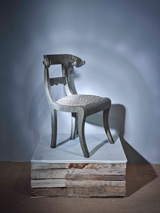STRUCTURAL FEATURES: This side chair is a rather attractive amalgamation of European form and Indian ornamentation, one of the results of the thus-created independent style called Anglo-Indian. This wood is repousséd with intricate silverwork and a richly cushioned seat. During the Mughal period, thrones of state were often covered with gold and silver work, though the processes of chasing and cladding – working sheets of metal by pushing the surface inwards, typically over a hard surface, to create patterns. That earlier, regal style was adapted here for domestic use.
STYLISTIC FEATURES: The curved toprail at the back of the chair has an intricately sculptured finial comprising a ram’s head design, running parallel to the horizontal back slat. The ram head’s earlier appearance could be attributed to the jewelled and enamelled daggers of the Mughal period. The work of skilled designer-craftsmen, repoussé involves hammering the metal into relief from the reverse. The front legs are of the sabre style, flaring out slightly like the name suggests, a sabre or sword.
Courtesy: The Taj Mahal Palace, Mumbai



RAM-HEAD CHAIR
DESIGNER: Unknown
MATERIAL: Silver sheet on wood
STYLISTIC INFLUENCE: Anglo-Indian
DESIGNER: Unknown
MATERIAL: Silver sheet on wood
STYLISTIC INFLUENCE: Anglo-Indian

